Status of Consideration of Biodiversity Credits in Japan
2/1 2024
Author: Naoko Hamashima
With respect to the conservation of biodiversity and natural capital, biodiversity credit schemes are in place in many countries around the world. Although there is no common definition of biodiversity credits, this section describes biodiversity credits as a mechanism whereby, for example, compensatory lands for development are established, credits are generated from the conservation of such lands, and the purchase of credits is deemed to have mitigated the impact of development in another location. In Japan, the 30 by 30 economic incentive study group in FY2022 decided not to pursue offset credits and banking schemes for the time being. This paper outlines the ecological situation in Japan that lies behind this decision.
The Japan Biodiversity Outlook has been compiled three times since 2010 as a comprehensive assessment of biodiversity and ecosystem services. The most recent JBO3 analyzes the direct causes of biodiversity loss in Japan in four categories.
The First Crisis is the crisis caused by human activities, such as development and overharvesting. Less than 20% of Japan’s total land area remains covered by undisturbed vegetation. Currently, while the pressure of development on ecosystems has lessened compared to the periods of high economic growth and the bubble economy, the effects of past conversions to ecosystems may continue, with relatively smallscale conversions continuing.
The Second Crisis is the crisis caused by decline in human intervention in nature. There is concern that the mosaic pattern of Satochi-Satoyama may disappear as a result of the approximate tripling of the area of abandoned farmland during 1975-2015.
The Third Crisis is the crisis caused by things newly brought by humans. While eutrophication of lakes and closed waters has been on a lessening trend over the past two decades, the crisis facing ecosystems caused by invasive alien species has worsened.
The Fourth Crisis is the crisis caused by the global environmental changes. The average temperature in Japan has increased at a rate of 1.26°C per century. The climate change over the past three decades typically caused the northward extension of the distribution of certain species of bamboo (Moso bamboo: Phyllostachys edulis and Japanese timber bamboo: Phyllostachys bambusoides) that grow in warm climates, and the distributional enlargement of southern butterflies to the northern areas, as well as coral bleaching apparently caused by the rise in seawater temperature.
For each crisis, the table below summarizes the degree of impact and the long-term and current trends of impact. The table shows that the impact of the second crisis, in particular, tends to increase.

Through the reduced number of primary industry workers resulting from changes in the industrial structure, reduced use and management of Satochi-Satoyama has resulted in reduced quality of management of secondary nature, causing deterioration of ecosystems. From the viewpoint of human population dynamics, the population decrease from the mid-2000s was coupled with the net positive flow of people from rural areas to the three major metropolitan areas, with the exception of a brief period in the first half of the 1990s. This has triggered the decline of rural areas, where relatively more people are engaged in the primary industry.
Loss of biodiversity leads to a decrease in ecosystem services. The following chart shows an analysis of the situation and causes for each good, especially for the services supplied.

The former includes overfishing in coastal areas (overuse) and degradation of resource conditions due to habitat destruction, etc., while the latter includes underutilization of resources (underuse) due to changes in dietary habits and increased imports of agricultural and forest products from overseas, etc. The latter is due to the underutilization of resources (underuse) caused by dietary changes and increased imports of agricultural and forest products from overseas. According to the Ecological Footprint indicator, Japan depends on foreign countries for approximately 3.1 times the amount of resources that can be produced domestically, and this is the background of underutilization. It can be seen that underuse is a cause of supply service decline, especially for terrestrial supplies such as crops and timber.
In light of the ecological and social conditions described above, even if a banking system were to be established in Japan, demand for credits is unlikely to arise because development pressure is not high. This is one reason why the study group decided not to pursue offset credits or a banking system for the time being.
Other technical issues include the fact that in Japan, extremely diverse ecosystems have been formed on a small area of land, making it difficult to ensure equivalence of quality. In addition, if the quality of nature that has been devastated by underuse can be maintained through appropriate maintenance and management, it is theoretically possible to credit the difference.
It is difficult to immediately consider a system that would create credits in Japan, given the technical challenges, and there is currently no development pressure that would require immediate consideration.
The Ministry of the Environment is attempting to accumulate empirical data through initiatives such as "nature symbiosis sites. The Ministry of the Environment of Japan certifies "nature symbiosis sites" as sites that contribute to the achievement of 30 by 30, one of the targets based on the Kunming Montreal Biodiversity Framework. In the first round of certification in the first semester of FY2023, 122 sites were certified. Of these, 76 applications were submitted by companies, indicating the potential for private-sector funds to be invested in nature. In addition, the Ministry of the Environment is currently establishing a system to certify that when human, material, and financial support is provided to a site for symbiosis with nature, that support has been provided and that such support is linked to the maintenance and improvement of the quality of the site for symbiosis with nature. Through the operation of such a system, it is expected that empirical data will be accumulated on which sites and to what extent human intervention contributes to the maintenance and improvement of the quality of the ecosystem.
Reference:
Working Group for Comprehensive Assessment of Biodiversity and Ecosystem Services, Ministry of the Environment, Japan, March 2021. https://www.biodic.go.jp/biodiversity/activity/policy/jbo3/generaloutline/files/JBO3_pamph_en.pdf
